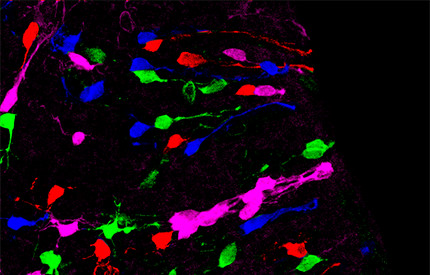Study reveals new insights into early stages of brain development

Researchers from King’s College London have made a significant advance in our understanding of a particular type of brain cell, which may one day have implications for the treatment of neurological disorders.
The study, published in Science, suggests that the fate of brain cells called cortical interneurons are essentially pre-determined by particular genes early during developement, rather than determined by their interaction with other cells later during brain development. Researchers from the Centre for Developmental Neurobiology and the MRC Centre for Neurodevelopmental Disorders at King's College London, along with colleagues at Yale University, tracked the development of interneurons in the developing brains of mice.
Cortical interneurons make up about 20% of cells in the cerebral cortex, the region of our brain that is responsible for complex functions such as learning and memory. Interneurons help control the activity of other brain cells, putting a brake on activity that might otherwise get out of control. There are 20-30 different classes of interneurons, each with very specific functions, and until now it has been unclear how cells develop into the different classes.
‘Our study demonstrates that very shortly after interneurons are born they seem to be already committed to develop into a particular fate,’ says lead researcher Professor Oscar Marín. ‘This suggests that the genetic programmes which determine the fate of a particular cell are locked in very early during development.’
Dysfunctional interneurons are implicated in brain diseases such as epilepsy, schizophrenia, anxiety, and autism. In future, understanding the genetic programmes that determine how interneurons develop may make it possible to grow specific classes of cortical interneurons in the lab.
‘It is very early days, but if we were able to generate specific human interneurons, we could potentially use cell therapy – transplanting lab-grown neurons into the brains of patients – to tackle disorders such as intractable epilepsy,’ says Professor Marín.
This research was supported by grants from the Wellcome Trust, the National Institute for Health, the Medical Research Council, and the Biotechnology and Biological Sciences Research Council.
Notes to editors
Paper reference:
‘Early emergence of cortical interneuron diversity in the mouse embryo’ by Mi et al., Science, DOI: 10.1126/science.aar6821
To contact the authors, or for further media information, please contact: Robin Bisson, Senior Press Officer, Institute of Psychiatry, Psychology & Neuroscience, King’s College London, robin.bisson@kcl.ac.uk / +44 20 7848 5377 / +44 7718 697176.